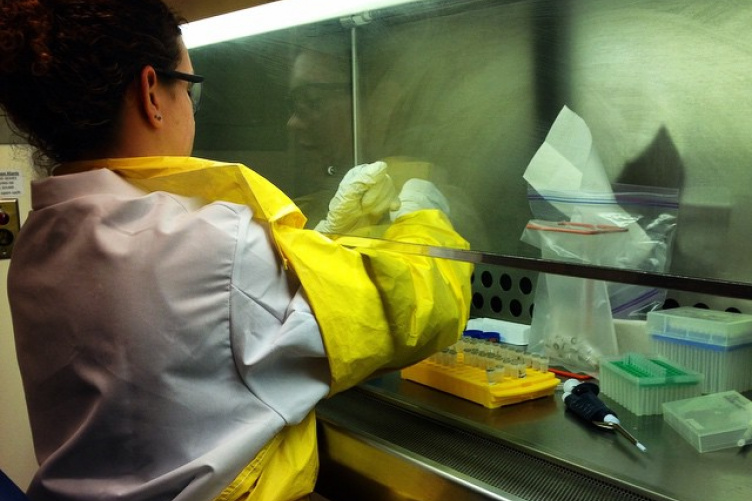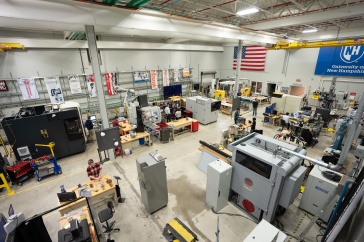
In the winter of 2006, colonies of bats hibernating in Albany, New York, began dying from a disease commonly known as white-nose syndrome because of the powdery looking fungus that develops on the bats’ faces. As the disease has spread, big and little brown bat populations across the country have been decimated; nearly six million have died in the last nine years.
While much of the research on Pseudogymnoascus destructans, or white-nose syndrome (WNS), has been done on cave colonies, there isn’t as much data on bats that winter in artificial structures such as the abandoned military bunkers found at Odiorne Point in Rye, New Hampshire, where samples for the research Kimberly Celona ’17 conducted on WNS this the summer were taken.
Celona, a biomedical science major, received a Summer Undergraduate Research Fellowship (SURF) grant from UNH’s Hamel Center for Undergraduate Research. With guidance from Jeff Foster, assistant professor of molecular, cellular and biomedical sciences, Celona spent last winter studying WNS before submitting her application. Once it was approved, she underwent 40 hours of biosafety training so she could work in the lab extracting DNA from bat tissue swabs collected from the bunkers. 
That training was important because the extraction process can create fungal spores that could have spread the disease if it was present, Celona says.
“I worked in a biosafety cabinet that was six feet wide and wore a Tyvek® gown and two sets of gloves,” Celona says. “I was trained in a way that was taken very seriously.”
Working with Foster and UNH research scientist Kevin Drees, Celona aimed to determine if WNS was in the artificial habitat, either in the large brown bats or on the walls of the bunkers. By extracting and purifying the DNA, they were able to see if the bats had WNS. The negative results were helpful in showing the man-made shelters may be a safe place for bats to hibernate and in supporting a previous notion that large brown bats — those found in the bunkers — might not be as affected by white-nose syndrome as little brown bats.
“It’s annihilating the little brown bats. You used to see them out feeding at dusk. Now you don’t,” Celona says. “Bats are critical in helping prevent the spread of disease. They help with insect control. If the bat populations decrease, it could cause a major shift in the ecosystem. We could see an increase in vector-borne diseases like West Nile or triple E (eastern equine encephalitis).”
 The Derry, New Hampshire, resident says her research, which will be added to a larger, ongoing project, has offered valuable information to what is known about artificial hibernation sites and white-nose syndrome.
The Derry, New Hampshire, resident says her research, which will be added to a larger, ongoing project, has offered valuable information to what is known about artificial hibernation sites and white-nose syndrome.
Drees, of the department of molecular, cellular and biomedical sciences, notes UNH is part of a “continent-wide sampling and assay effort” aimed at tracking white-nose syndrome and locating structures such as the old military bunkers where bats are colonizing.
“These bunkers may serve as sanctuaries from the disease, and since they are manmade, it may be possible to disinfect them to decrease the risk of bats contracting white-nose syndrome,” Drees says. Additionally, they are searching for populations of bats that don’t appear to get WNS. “These bats may have genes that allow them to resist the disease, or conditions at the sites themselves may promote the survival of bats.”
Drees says research opportunities such as those afforded through the undergraduate research fellowships are essential for budding scientists. “Although lecture and lab courses convey the basics of science, the training and knowledge one can acquire from an internship is incomparable, as is experiencing the lab/field environment, in helping to decide whether research is the right career for you.”
Celona, who grew up on a farm with a parent in the medical profession, says she would like her future career to combine her interests in public health and environmental health
“I really like challenging subjects and research was definitely that. Every day something went wrong,” Celona says. “I wasn’t sure I was going to like research and then I found that being in the lab was my favorite part of the day.”
Bat photo: CREDIT MAREK STEFUNKO / FLICKR/CC
-
Written By:
Jody Record ’95 | Communications and Public Affairs | jody.record@unh.edu
















































